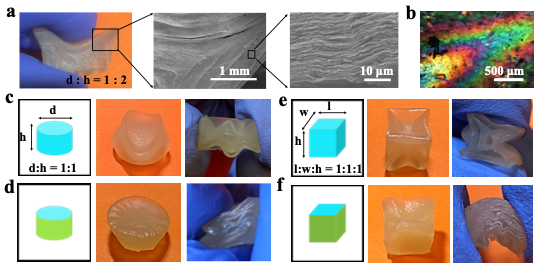(668e) Anisotropic Chitosan Hydrogels with Multi-Length-Scale Layered Structures Via Directional Drying
AIChE Annual Meeting
2022
2022 Annual Meeting
Materials Engineering and Sciences Division
Hydrogel Biomaterials III: Design and Characterization
Thursday, November 17, 2022 - 4:30pm to 4:45pm
Many biological tissues contain multi-length-scale anisotropic architectures, which not only facilitates the living organisms with mechanical toughness but also plays an essential roles in surface lubrication, force generation, and cell proliferation. Anisotropic hydrogels have been developed to mimic biological tissues by self-organizing various components into hierarchical structures in the presence of directional stimuli, such as the ice-templating, mechanical forces, magnetic or electric fields, and ion gradients. Additionally, some nanofillers with high aspect ratio can be assembled into nanoscale anisotropic hydrogels by utilizing concentration or vacuum-assisted filtration technology. However, most of those hydrogels are mechanically weak, only contain either microscale or nanoscale features, and limit to thin films or small-sized samples. In some cases, complicated post-processing processes are needed to fabricated anisotropic hydrogels with multiscale structures, which is time consuming and may cause poor biocompatibility of the final products. In this work, we present a simple method to construct super-tough anisotropic hydrogels multi-length-scale layered structures, by the self- assembly of rigid chitosan nanofibers in a chemically crosslinked gel network through a controlled drying treatment. The acquired chitosan hydrogels display highly aligned self-templated hierarchical structures at across millimeter to micrometer and to nanometer scales. Meanwhile, their mechanical strength was enhanced as approximately ten times as that of the original gels. Taking advantage of the drying-induced realignment of polymer chains during the process, the hierarchically layered structures in the hydrogel can be controlled with desired directions, which can create designed anisotropic shape change of the hydrogel objects.
Figure: Photographs of the anisotropic chitosan hydrogels prepared by controlling the evaporation of water. a), SEM images of the cross-sectional structures with multi-length-scale layers; b) Polarizing optical microscopic images of the chitosan hydrogel showing crystalline structure. c)-f) Naked and vacuum grease-covered cylinder- and cuboid-shaped hydrogels upon drying treatment. The green color represents the vacuum grease.
